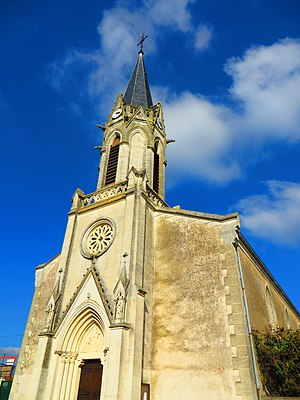Bioncourt
| Bioncourt | ||
|---|---|---|

|
|
|
| region | Grand Est | |
| Department | Moselle | |
| Arrondissement | Sarrebourg-Château-Salins | |
| Canton | Le Saulnois | |
| Community association | Saulnois | |
| Coordinates | 48 ° 48 ' N , 6 ° 22' E | |
| height | 194-290 m | |
| surface | 8.21 km 2 | |
| Residents | 307 (January 1, 2017) | |
| Population density | 37 inhabitants / km 2 | |
| Post Code | 57170 | |
| INSEE code | 57084 | |
 Saint-Remi church |
||
Bioncourt is a French commune with 307 inhabitants (as of January 1, 2017) in the Moselle department in the Grand Est region (until 2015 Lorraine ). It belongs to the communal association Communauté de communes du Saulnois .
geography
Bioncourt is located in the Saulnois , 60 kilometers southeast of Metz and 20 kilometers northeast of Nancy on the Seille River . The hamlet of Alincourt, which is northwest of the town center, belongs to the municipality .
history
Bioncourt was first mentioned in a document as Bionis curtis 933. The place name is composed of the Franconian name Beggo and the Latin word curtis and means "Beggos Hof".
Alincourt was first mentioned in 1180, it was the seat of a seigneurie that belonged to the castellany and Bailliage of Nancy.
Bioncourt was also the seat of a Seigneurie, already towards the end of the 13th century the first Seigneur of Bioncourt, André de Bioncourt, son of Geoffroy d' Amance, took the name of the village. The family disappeared as early as the 14th century. From 1594 to 1751 Bioncourt was part of the Amance castellan , which was subordinate to the Nancy Bailliage. After that it belonged to the Bailliage of Château-Salins . In 1790 Bioncourt became the canton capital and remained so until 1801.
In the 18th century, Bioncourt was the seat of a barony owned by the Catoire family, who took the name Catoire de Bioncourt. From 1771 to 1775 the then Baron Jean-Batiste-Nicolas Catoire tried to make the Seille navigable. Then Charles de Vincent acquired the barony. He is buried in the Bioncourt cemetery and a street is named after him.
The parish of Bioncourt was part of the administration of the Archpriest of Delme , who was subordinate to the Archdeacon of Vic-sur-Seille .
In 1793, Bioncourt received in the course of the French Revolution (1789-1799) the status of a municipality and in 1801 the right to local self-government. From 1801 to 1871 it belonged to the former Meurthe department , which was renamed the Meurthe-et-Moselle department in 1871 . In 1871 the community was incorporated into the newly created realm of Alsace-Lorraine of the German Empire due to changes in territory due to the course of the Franco-German War (1870–1871) . The realm of Alsace-Lorraine existed until the end of the First World War (1914–1918) and was then dissolved. At the time, Bioncourt was in the Moselle department, this change was retained in 1918 when Moselle was again assigned to France. As a French-speaking town, Bioncourt was one of the last 247 communities whose name was Germanized on September 2, 1915. The name was changed to "Bionshofen" and was the official place name until 1918.
Population development
| year | 1962 | 1968 | 1975 | 1982 | 1990 | 1999 | 2007 |
|---|---|---|---|---|---|---|---|
| Residents | 223 | 233 | 224 | 282 | 310 | 309 | 311 |
coat of arms
The coat of arms of the municipality corresponds to the coat of arms of the Bioncourt family from the 13th century, it is silver with a blue crossbar.
Web links
- Bioncourt on annuaire-mairie.fr in French
Individual evidence
- ^ Ernest Nègre: Toponymie générale de la France . tape 2 . Librairie Droz, 1996, ISBN 978-2-600-00133-5 , pp. 886 (French, in Google Books [accessed March 13, 2010]).
- ^ Société d'archéologie lorraine, Comité du Musée lorrain [Nancy] (ed.): Journal de la Société d'archéologie et du Comité du Musée lorrain . tape 47 , no. 1 . Crépin Leblond, 1898, ISSN 1770-6130 , p. 14-17 (French, in Gallica [accessed March 13, 2010]).
- ^ A b Société d'archéologie lorraine, Comité du Musée lorrain [Nancy] (Ed.): Journal de la Société d'archéologie et du Comité du Musée lorrain . tape 46 , no. 1 . Crépin Leblond, 1897, ISSN 1770-6130 , p. 270-274 (French, in Gallica [accessed March 13, 2010]).
- ↑ Web site of the Catoire de Bioncourt family (French). Accessed March 13, 2010.
- ↑ Un personnage illustre (1757–1834) on mediathequebioncourt.free.fr in French.
- ↑ Tourism in Lorraine, Bioncourt ( page no longer available , search in web archives ) Info: The link was automatically marked as defective. Please check the link according to the instructions and then remove this notice. (French) Retrieved March 13, 2010
- ^ Henri Lepage: Dictionnaire topographique du département de la Meurthe . In: Société d'archéologie lorraine et du Musée historique lorrain (ed.): Dictionnaire topographique de la France . 6th edition. tape 14 , no. 18 . Imprimerie impériale, Paris 1862, p. 3 f. + 17 + 30 + 40 + 118 + 126 + 128 (French, in Google Books [accessed on March 13, 2010]).
- ^ Bioncourt on cassini.ehess.fr (French). Retrieved March 11, 2010
- ↑ Les 247 dernières communes à noms français, débaptisées seulement le 2 septembre 1915 (French) Retrieved March 13, 2010
